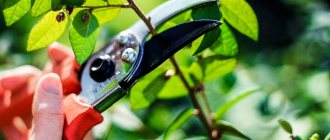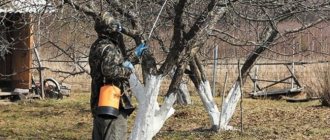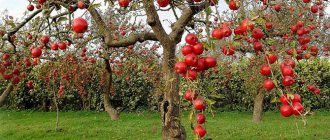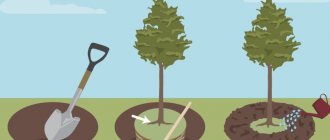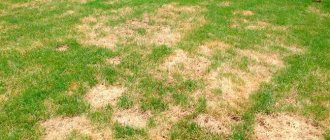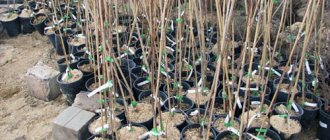Some trees are pruned in the fall, while others are pruned in the spring. Experts advise pruning in the northern regions in the spring, and in the southern regions in the fall. The main thing is to do this when the tree is resting.
Why is pruning needed?
Pruning is carried out for the correct formation of the crown, as well as for sanitary cleaning of diseased, damaged and dried branches.
If pruning is done correctly, it will not only improve the condition of the plants, but will also prevent large amounts of snow from accumulating on the branches and prevent branches from breaking.
Why is it important to trim trees:
- the plant is better illuminated;
- better ventilated;
- gets sick less often;
- the tree produces beautiful and large fruits;
- begins to bear fruit earlier, and the fruiting period lasts longer;
- the tree looks neat and well-groomed.
The main pruning of heat-loving crops is recommended to be done in the spring. However, autumn pruning also has its advantages:
- plants have time to recover from injuries before the onset of frost, and in the spring they immediately begin active growth;
- fruit trees tolerate cold weather more easily; because the thinned crown does not accumulate snow, there is no risk of kinks;
- the plant does not become infected with fungal infections, since at this time the fungi are already “sleeping”;
- A summer resident has less work to do in the fall than in the spring and summer.
But don't get too carried away. Despite all the benefits of pruning, this procedure is very stressful for the tree. Excessive pruning will damage the trees and the yield will be significantly reduced.
How to process cuts
There are no gum leaks, parasites, or fungal spores in winter, but wounds are still treated. Var is not used. In the cold, it loses its plasticity, does not stick to wood, and crumbles. The saw cuts are covered with paint. Gardeners take white.
Reliable means of protecting fruit trees from pests When many harmful insects, rodents and other people who like to spoil the harvest of fruit trees come out,…
This color reflects sunlight from damaged tissue. It does not overheat during the day, so it does not shrink at night, so cracks do not appear on it. Sections treated with white paint are easy to find in the spring, assess the condition of the wounds, and carry out finishing trimming.
In winter, winter-hardy trees can be pruned, following the rules. But in the spring there will be no less work. You will have to inspect the crown, remove frostbitten shoots, and cut out stumps. Treat fresh wounds with a 1% solution of copper sulfate.
When to prune fruit trees in the fall
It is difficult to name the exact date of pruning. Firstly, it all depends on the climate in your region and the weather in this particular season, and secondly, in general there are no strict requirements for dates. The main thing is not to miss the time during which pruning will take place without harm to the trees and the future harvest.
The gardener chooses the time of pruning in the fall himself. But you can focus on the following criteria:
- all work in the garden has already been completed (the trees have been fed, disinfected, mulched, watered);
- the leaves have fallen and been removed from under the trees;
- the weather is dry and cool;
- There are still 2-3 weeks left until stable negative temperatures.
As a rule, in the middle zone this time falls on mid-October - the first ten days of November. In the southern and northern regions, the dates are shifted.
Start autumn pruning after leaf fall, when sap flow stops and the plants begin a period of rest. And complete the process 2-3 weeks before the onset of frost. This way, cutting will not weaken the plants, but, on the contrary, will strengthen their immunity.
- Preparing the garden for winter: what work to do in the fall
We tell you what the autumn preparation of the garden for winter involves.
How to whiten trees in the fall
For autumn painting of trees, various mixtures are used: water-based paint, water-dispersion paint, as well as well-known lime solutions. The main requirements for whitewashing compositions are painting the surface white, allowing the skin to “breathe” underneath, and also the duration of stay on the bark.
Modern industry offers a wide range of whitewashes for trees. But you can also cook them yourself. In this case, the composition used for coloring should include the following components:
- white clay, lime or chalk - to give it a white color;
- glue, milk or soap - for better adhesion to the bark;
- fungicide – for disinfection.
Attention!
When using purchased paint, be sure to make sure that it is intended specifically for whitewashing living trees and not for any other wood.
But the whitewashing itself is only the final step in a four-step process. It is preceded by cleaning the trunk, its disinfection, as well as healing of wounds.
What to pay attention to when pruning
You should not prune trees ahead of schedule. Pruning, for example, apple trees in September, which is sometimes practiced by hasty summer residents, will not do anything good. At this time, the leaves are still firmly attached to the trees, and it will be more difficult to see the crown.
- Pruning trees and shrubs - tips and tricks
How to prune trees and shrubs for a beginner and what you need to know for this - find out from our article!
Late pruning is also fraught with consequences. The plants will not have time to recover before the onset of cold weather, so the bark at the cut site may freeze. This will lead to drying out of the wood and subsequent death of green spaces.
It is important that pruning takes place on a dry, clear day. It is not advisable to prune trees during rain or immediately after it.
Carry out work in the garden with sharply sharpened and disinfected garden tools (secateurs, hacksaw). Otherwise, instead of practical benefit, you will provoke disease in your plants. Prepare a stepladder and gloves in advance. Treat the cut areas with RanNet, BlagoSad, Zhivitsa or garden varnish.
Preparing tools
The main tools for pruning fruit trees in winter are pruning shears, loppers and a hand saw - a hacksaw with a fine tooth. In addition, to treat open wounds you need to stock up on garden varnish. Before carrying out work and after completion, all tools must be disinfected with a solution of any alcohol-containing liquid or one percent copper sulfate. Although the risk of infection during winter pruning is minimal, hygiene rules must be strictly observed.
A big mistake would be to use a gasoline or electric chain saw instead of a hand hacksaw. Such instruments leave deep, uneven wounds with ragged edges that take a very long time to heal. Using a chainsaw is only possible when large dry branches are completely removed.
Important! In winter, there is practically no chance of scuffing and creasing when cutting down large branches.
How to trim trees correctly
When pruning in autumn:
- carry out sanitary cutting of shoots;
- remove diseased branches affected by pests, as well as those that have dried out or broken;
- cut off all root shoots and tops. They only thicken the crown, draw in food for themselves, but are not needed for fruiting;
- remove weak, immature branches, as well as crossing and closely growing ones;
- get rid of shoots that grow inside the crown or vertically upward. The tree also does not need branches that point downwards.
All cut branches are removed from the site or burned.
Leave those branches that grow perpendicular to the trunk. They will give the greatest harvest.
The effect of pruning on the condition and fruiting of the tree
In some ways, each pruning is stressful for the plant, but with its help you can regulate the time of fruiting and the overall development of the tree trunk. Remember, there are two sides to every coin, for example, if you eliminate branches that grow in the wrong direction and add unnecessary density to the canopy, while not using shortening of annual growth, this strategy will significantly speed up the time for the tree to begin to bear fruit. Especially when compared with specimens to which such methods were not applied. However, this risks the fact that the crown will be long-legged and unstable, and the branches will become characterized by weakness and a short life span, which is not much different from an unpruned representative of the flora.
Post-planting pruning
When pruning, inexperienced gardeners often sin by shortening the branches too much. If one-year growths of a young and actively growing nut are shortened extensively and without any reason, this will lead to unnecessary density of the crown and a delayed onset of fruiting. If the variety is characterized by fruits at the very end of long branches, then fanatical shortening will lead to a significant reduction in the number of fruits. In addition, you should know that thoughtless pruning reduces the tolerance to cold in winter. Strong pruning is justified only if the plant is young, but its growth is weak.
It is necessary to take into account that if you combine cutting with slight or medium pruning of one-year growth, this will slightly delay (maximum 2 years) fruiting during the first couple of harvests, but not their level as a whole. The advantages of this will be a superbly built crown, characterized by strength, besides, the branches will be more stable, and there will be more fruit on them.
If the gardener wants to ensure that the fruits are consistently large, it is necessary to intensively prune the annual growth every year, but also take into account that the total yield from a particular tree will be significantly reduced. The crown of such trees becomes dense, and a lot of time has to be spent eliminating unnecessary branches that will weaken the yield potential.
Pruning an apple tree in autumn
When to prune : The procedure begins immediately after the leaves fall and is completed before the onset of frost. In the middle zone, this time usually falls in mid-October - early November.
What to trim : Cut out damaged, dried, weakened and close-growing branches.
- How to get rid of an extra trunk on an apple and pear tree
A double trunk can kill a tree. We will tell you in this article how to get rid of an extra trunk and what to do if an apple or pear tree is cracked.
Rejuvenating pruning of old apple trees is carried out gradually, over 2-3 seasons. In the first year, a third of the old branches are cut out, the next year another third, and the last third is left for the third year.
In the year of planting, an annual seedling may have no branches, or only a few underdeveloped branches. In the first case, it is shortened to 80-100 cm. In the second, the central conductor is shortened, and the branches growing in the area of the future trunk at a height of up to 70 cm from the ground are removed. The same applies to those located higher up the trunk, but at an acute angle to it. But those that extend from the trunk at almost a right angle are left, shortening up to 3-5 buds from the trunk.
In the second year of life, the seedling is left with 3-5 of the strongest and correctly placed branches. The central conductor is also shortened so that it is only 20 cm above the upper branches. If a second “candidate” for conductor appears, he is also cut out.
For 3-5 years of life, pruning of the apple tree is reduced to a minimum. The gardener cuts out tops, damaged branches, as well as those shoots that grow deep into the crown or rub against others.
- Pruning apple trees in autumn - tips for beginners in pictures and videos
Now is the best time to prune apple trees in the fall. Don't know how to do it right? Then watch our diagrams and detailed videos.
Preparing the garden for winter
In the fall, it is imperative to treat trees with iron or copper sulfate. I alternate these preparations: in the fall I treat with three percent copper sulfate, in the spring with iron sulfate. Or vice versa. Vitriol will protect your garden from fungal diseases.
After processing, at least a bucket of humus and a liter jar (half a kilogram) of wood ash must be added to the trunk circle of each tree. Fertilizers need to be scattered over the entire tree trunk circle, the border of which is outlined by the projection of the crown, and then planted to a depth of 15-20 cm.
Then you need to pour about 200 liters of water under each tree older than three years. Even when light frosts begin, the root system of trees is still developing, accumulating nutrients, and to prevent the bark on the trees from bursting in winter, you need to saturate the roots with moisture, especially if the autumn was not rainy.
And do not forget to whiten the trunks and frame branches to the height that you can reach, because in winter and early spring there are temperature changes: during the day it is already quite warm, but at night it can become very cold. This causes deep cracks, so-called frost holes, to form on the bark.
Whitewashing trunks and skeletal branches with gentle whitewash paints will protect trees from such troubles, especially young seedlings that are less than two years old. If you do not apply a protective layer to the trunks, a tree with frost damage will suffer for a long time, and may not recover at all.
Pruning pears in autumn
When to prune : Timing depends on the variety, growing region and weather conditions. You can start pruning pears in the fall after fruiting has ended: this is the period from the end of August (in the northern regions) to the beginning of November (in the southern regions), two to three weeks before the first frost.
The suitable temperature for the operation is 8-12°C.
Trees of early varieties or varieties with low winter hardiness are pruned first so that they have enough time to recover. Frost-resistant pears are pruned before the end of October - beginning of November.
If you missed the deadline for pear pruning, it is better to postpone the procedure until spring. Otherwise, the tree may not cope with stress and will not survive the winter well.
What to prune : Remove dead and diseased branches. Cut off the young basal shoots, trim the tops, thin out the crown. Trim branches that you will remove in the spring. Trim the annual growth to a bud. Also remove branches that grow inward. Side branches that interfere with the penetration of light are removed “in a ring”.
An annual tree is pruned at a height of 45-65 cm from the soil level. For two-year-old specimens, 3-4 skeletal branches are left, they are pruned at the same level, and the remaining shoots are removed. The conductor is cut 20 cm above the main branches.
a – branches growing too close, b – branches pointing down, c – branches pointing towards the side of the trunk, d – branches crossing
Older trees are mainly subjected to sanitary pruning.
- Pruning pears in the fall for beginners: visual diagrams, clear tips
Autumn pruning raises many questions for novice gardeners. Let's figure out which branches need to be removed from the pear and when is the best time to do this so that the tree survives the winter well and pleases you with juicy fruits next season.
To rejuvenate an old pear, first shorten its top. But if proper pruning has been carried out annually, then you can immediately begin thinning - remove non-fruit-bearing, dry, old branches, cut out shoots that grow parallel to the trunk or at an acute angle to it. All other shoots are shortened by 1/4 of the length.
Advice from experienced gardeners for beginners
Experienced gardeners, when planning and carrying out winter pruning of apple trees, advise beginners to strictly adhere to the following rules:
- You should always start work with a careful inspection of the tree and drawing up a clear plan for future work - identifying the branches that need to be cut, shortened, etc. In the first stages, it is useful to carry out preliminary markings using ordinary school chalk (the rule “measure twice, cut once " in this case is of paramount relevance).
- Weak branches need to be shortened greatly, leaving 2-3 buds, while for stronger branches the cut is made at a height of 8 or more buds.
- Skeletal branches should be left longer, and growth (vegetative) branches should be shortened more.
- A seedling planted in the fall is not pruned for a year and a half, but when planted in spring, the tree can begin to form immediately.
- The branch must be shortened strictly above the bud, because if you cut above the bud, the branch will dry out.
- All work must be carried out only with very sharp and pre-disinfected tools.
- You should try to make cuts as quickly, accurately and evenly as possible, without allowing the bark to lift. When working with thin branches, a pruning shear is used, and the procedure is carried out in one movement; to remove thick branches, it is better to get an electric or chainsaw.
- After rejuvenating pruning in the spring, fertilizers should be added to the soil under the apple tree - both organic and mineral.
- Before pruning yourself, it is wise to take several practical lessons from experts, best of all by inviting them to your own site and get specific advice regarding a very specific tree.
- You need to prune the tree every year, starting this work immediately after planting, then the apple tree will form correctly, and in the future it will require much less effort to maintain it in a “working” condition.
Pruning an apple tree is a whole science, so under no circumstances should you begin performing such a procedure without serious preparation, both theoretical and practical. For crown formation, rejuvenation, stimulation of fruiting, thinning and sanitary care (removal of dry and damaged branches), different growing seasons can be used, but the main emphasis in this type of work falls on the end of winter or the earliest spring. By choosing the wrong time or even just not guessing the weather, you can completely destroy the tree, but if everything is done correctly, the apple tree will definitely respond to the efforts spent with a rich harvest.
Pruning plum trees in autumn
When to prune : The tree is pruned from mid-September to the end of October, after leaf fall, so that it has time to prepare for wintering. It is advisable to do it 2-3 weeks before the first frost.
What to trim : Long and fast-growing branches are shortened by a third so that they do not break under the weight of snow and gusty winds. If necessary, you can shorten the top of the tree. All damaged and broken shoots are also cut out, since they are more susceptible to frost than others. At this time, dry and diseased branches of an old plum tree are pruned.
- Proper pruning of plums - tips for beginners (diagrams, photos, videos)
We tell you how to prune plum trees in spring, summer and autumn.
In regions with mild winters, not only sanitary, but also formative pruning is carried out in the fall. If the top extends above 2.5 m, it is shortened. After this, shoots that grow too quickly are cut off. Competitor shoots are cut out, which will actively grow in the spring and thicken the crown, preventing the sun's rays from illuminating all parts of the plant. In the unstable climate of the middle zone, it is better to postpone this matter until spring.
It is impossible to fully prune a plum in the fall in the year of the tree’s first fruiting - in this case, only problem branches are removed.
Pruning cherries in autumn
When to prune : Work is carried out from September to early November, depending on the weather in your region: the warmer it is, the later you can start working. The main indicator is leaf fall. At this moment, sap flow inside the trunk ends, and the tree will tolerate the loss of branches more easily. But it’s important to get there before frost!
What to prune : Autumn pruning of cherries is usually of a sanitary nature. Remove dry, diseased and damaged branches that can become sources of infection. And also thickening branches that grow inside the trunk, branches that “look” down, young basal shoots. Also trim tops, young growth on the trunk, lower branches at forks and crossing shoots.
Leave the formation of the crown for the spring.
Do not prune one-year-old seedlings in the fall, as well as young immature plants. It's better to do this in spring or summer. Subject the remaining trees to the procedure only if they are generally strong and healthy.
- Pruning cherries in the fall - tips for beginners in pictures
We tell you which specific branches need to be removed so that the trees develop properly and bear fruit abundantly in the future.
